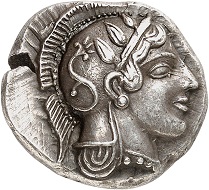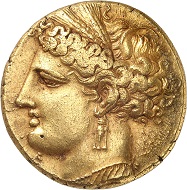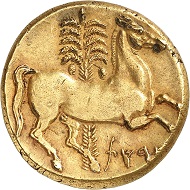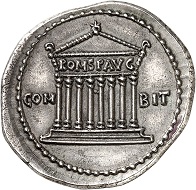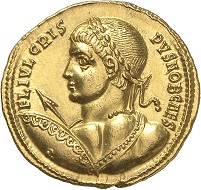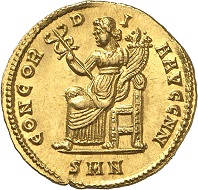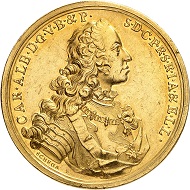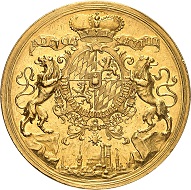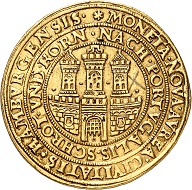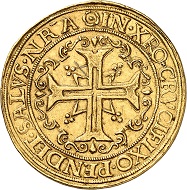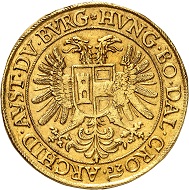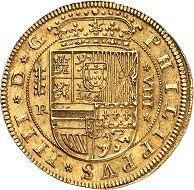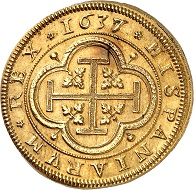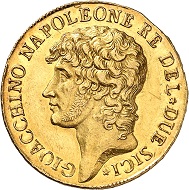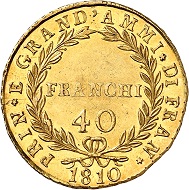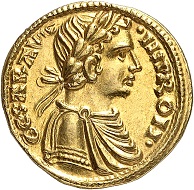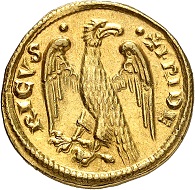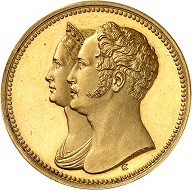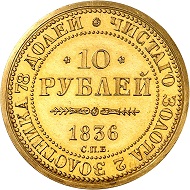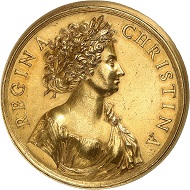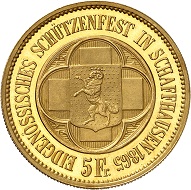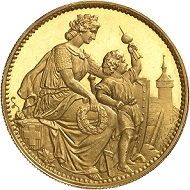02-12-2018 – 01-01-1970
Auction 10
Numismatic highlights at Numismatica Genevensis SA
On December 3, 2018, the 10th auction held by Numismatica Genevensis will take place at the Hotel Le Richemond in Geneva. It is a double anniversary: this 10th auction coincides with the auction house’s 30th anniversary and as per usual, the catalog contains an abundance of exceptionally beautiful coins and medals from antiquity to the 20th century. The selected items satisfy every aesthetic demand one might have. And all those who set great store by good provenance will discover coins originating from the best collections in the world. The new catalog attests to the reputation of Numismatica Genevensis of offering customers the most beautiful coins that money can buy.
No. 16: Athens. Didrachm around 465. Starr 75 (this specimen). From the Salvesen and von Hoffmann Collection, Sotheby (1995), No. 57. Only about a dozen privately-owned specimens. The most beautiful known specimen. Extremely fine. Starting price: 150,000 CHF.
Greek Coins
Anyone who loves ancient coins knows of the Abecassis, Bank of England, Biaggi, Cahn, Sir Arthur Evans, Hoffmann, Hunt, Jameson, Kunstfreund, Mazzini, Montagu, Peyrefitte, Pozzi, Salvesen, Trau and Vierordt Collections. The rapturing ancient coins and medals sold by Numismatica Genevensis stem from these collections – and numerous other ones. For example, the auction offers a stunning tetradrachm from Katane depicting the frontal visage of Apollo, which used to be part of the Hunt Collection. Connoisseurs will discover a double gold stater of Alexander the Great and possibly the most beautiful didrachm of classical Athens with a provenance dating back to 1968.
No. 25: Carthage. Electrum-tristater, ca. 260 B.C., unknown mint in Sicily. From Sternberg Auction 20 (1988), no. 508. Jenkins knows of only 16 specimens, 10 of which are part of public collections. Spectacular Greek electrum coin weighing 22.40 g. Extremely fine. Starting price: 300,000 CHF.
The highlight of all highlights is a spectacular electrum coin of Carthage, a tristater, which was minted at an unknown mint in Sicily in 260 B.C. It combines the greatest art of Greek engraving with Carthaginian monumentality.
No. 44: Hadrian, 117-138. Cistophorus, after 128, Nicomedia. From Leu Auction 18 (1977), No. 330 (cover piece). An exceptional coin on a wide planchet struck from an excellent die. Extremely fine. Starting price: 125,000 CHF.
Coins of the Roman Empire
At a hammer price of 2 million Swiss francs, Numismatica Genevensis SA holds the record for the most expensive Roman coin ever sold, which is a sestertius of emperor Hadrian. Ten years later you will find the most beautiful silver coin of Hadrian as lot number 44. A cistophorus depicting a magnificent portrait of the emperor from the province of Bithynia – yes, precisely the province where Hadrian’s beloved companion Antinoos was born – is in no way inferior to the aforementioned sestertius made by the maître de l’Alphée. The reverse features the temple of Roma and Augustus, which was built as the province’s heart of the emperor cult in Bithynian Nicomedia.
No. 65: Crispus, 317-326. Solidus 324, Nicomedia. From Vierordt Collection, Schulman Auction (March 5,1923), No. 2694, Mazzini plate XXX, 546 and Biaggi 2053, NGSA Auction 8 (2014), No. 143. An exceptional coin. Extremely fine. Starting price: 100,000 CHF.
Evidently, this is not the only important Roman coin offered in this auction. A selection of the most beautiful and rarest aurei and solidi of exceptional grade will also be sold. It is worth taking a careful look here because the quality of these pieces allows you to enjoy every single detail.
Islamic Coins
Numismatica Genevensis continues to make rarities of the Islamic world available for purchase. The array ranges from an early Arabo-Byzantine coin from Northern Africa in the early 8th century to a unique gift set of coins of the Persian Shah Reza Pahlawi presenting four extremely rare coins from 1927.
Coins and Medals from all over the World
The rarities presented in the second part of the auction are brought in from all over the world. No matter what field a collector is interested in, they will find coins and medals that might become the showpieces of their collection.
No. 97: Germany / Bavaria. Karl VII, 1726-1744. 20 ducats, Munich. Of extraordinary importance. Extremely fine. Starting price: 200,000 CHF.
German Coins and Medals
The section of modern coins in the catalog, written in French, begins with Allemagne, Germany. The second coin already is a very special rarity from Bavaria. Karl Albrecht, who became the second member of the Wittelsbach dynasty to ascend to the emperor throne as Karl VII, had a coin weighing 20 ducats minted in 1739 for representational purposes. The reverse features the silhouette of the city of Munich – underneath an elaborately decorated coat of arms crowned with a coronet.
No. 111: Germany / Hamburg. 10 ducats or portugaleser, undated (1578-1582), Hamburg. An exceptional rare coin. Very fine. Starting price: 150,000 CHF.
One will also find a portugaleser from Hamburg struck between 1578 and 1582, which imitates Portuguese gold coins, the material of which was used for the first large gold coins of the trade city at the Elbe River. A grafitto denoting Roman ten hints at the fact that when these coins were first issued, not everyone who used the portugalesers also knew that these pieces were worth ten ducats. The following half portugaleser worth five ducats was made using the same dies and is almost rarer than the aforementioned coin.
No. 129: Holy Roman Empire. Rudolph II, 1576-1612, or Mathias II, 1612-1619. 10 ducats, undated, Prague. Extremely fine. Starting price: 150,000 CHF.
The exact time of when the ten ducats showing the portraits of the rulers Maximilian I, Karl V and Ferdinand I were made cannot be determined, but it is known that it was minted in Prague. It was probably either emperor Rudolph II or Matthias II who ordered its production. It surely will be one of the many highlights that the section of Austria / Holy Roman Empire has to offer.
No. 152: Brazil. Maria I, 1786-1805. Gold bar 1792, Sabara. From the A.M. Huntington and the Hispanic Society of America (HAS 1001.57.5790) Collections. An outstanding piece of illustrious origin. Extremely fine. Starting price: 200,000 CHF.
A Unique Gold Bar from Brazil
In 1906, an extremely rare gold bar from Brazil was offered in a list of the Netherlands-based auction house Schulman. It is a bar weighing 5 ounces 1 octave and 54 grains (= 149.28 g) from 1792. Therefore, it was the heaviest and earliest piece ever to be put on the market. And it is to this day. There is only one bar that is heavier and older and it is stored at the museum of Sabara / Minas Gerais where the gold for this bar was dug and where the bar itself was made.
After many years of the gold bar being a jewel of the Huntington or Hispanic Society of America Collection, it can once again be purchased by collectors.
No. 179: Spain. Philipp IV, 1621-1665. 8 escudos 1637, Segovia. Extremely rare. Extremely fine. Starting price: 125,000 CHF.
The Best Portraits of the Italian Renaissance
Rarities from Spain, France, Great Britain – including an impressive batch of British gold coins from the time of the transition from the Late Middle Ages to the early Renaissance – are followed by Italy which encompasses more than 200 lots and thus constitutes a focal point of this auction.
The portraits of Renaissance rulers are especially well represented, not just on silver testoni but also on Italian gold coins.
No 431: Italy / Naples. Joachim Murat, 1808-1815. 40 franchi 1810. Only 18 known specimens according to MIR. A monument of the Napoleonic era. Very rare. Extremely fine. Starting price: 125,000 CHF.
The Risorgimento and the Italian Kingdom
The vast array of rare Casa Savoia coins, especially from the time when its members were the kings of Italy, is absolutely magnificent. One 20 lire piece dedicated to the elected King of Italy Vittorio Emanuele II is from 1860 and was minted using the proof technique in Bologna. This historical testimony of the Risorgimento of unique condition was struck in a mintage of 159 specimens only.
A selection of 15 silver essays struck in the Rome mint between 1927 and 1928 is just as unique.
No. 477: Italy / Sicily. Frederick II, 1197-1250. Half augustalis, undated (1231-1250), Brindisi. Finest style. The most beautiful known specimen. Extremely fine. Starting price: 50,000 CHF.
A Perfect Icon of Numismatics
Those who enjoy quality will be enthralled by the small half augustalis of Frederick II of Hohenstaufen. The engraving combines craftsmanship, which is in no way inferior to the work of ancient engravers, with the skill of abstraction that we know from the Middle Ages. Let us add the perfect condition and we are left with a unique rarity, a numismatic icon that satisfies the highest aesthetic demands.
No. 528: Russia. Nicholas I, 1825-1855. 10 rubel 1836, St Petersburg. Essay in gold made by Gube. From the Great Duke G. Mikhailovich Collection, from the Count Hutten-Czapski Collection. A unique essay of a stunning coin that was never issued, with exceptional provenance. Extremely fine. Starting price: 200,000 CHF.
A Russian Showpiece from the Grand Duke Mikhailovich and Hutten-Czapski Collections
There may well not be a better provenance than the one boasted by a Russian essay worth 10 rubles. Its obverse features the portraits of tsar Nicholas I and his wife Maria Fjodorowna, née Princess Sophia Dorothee of Württemberg. The Grand Duke Mikhailovich and Hutten-Czapski Collections will certainly offer an exceptional numismatic showpiece. It is an essay of a coin that was never issued.
No. 540: Sweden. Christine, 1632-1654. Gold medal of Giovanni Battista Guglielmada, undated (around 1685). From the Sacha Guitry Collection, Bourgey Auction (May 1963), no. 137. A unique medal with exceptional provenance. Extremely fine. Starting price: 75,000 CHF.
Sweden’s Sun
A small selection of large gold coins and medals of the Swedish queen Christina will be auctioned off. The iconic piece depicts the queen in antique style on the obverse and her motto on the reverse “Nec Falso Nec Alieno” (= Neither False Nor Borrowed). It features an anthropomorphic sun, which proves how much alike the French Sun King Louis XIV and his Swedish contemporary were in terms of the interpretation of their rule.
No. 546: Switzerland. Schaffhausen. 5 Francs 1865, off-metal strike in gold. Only two specimens! The most beautiful of the two. FDC. Starting price: 150,000 CHF.
Switzerland and the USA
Collectors will discover more than 70 lots of Swiss coins in auction catalog 10 of Numismatica Genevensis ranging from Celtic antiquity to the coins of the Confederation. Although one will encounter coins estimated in three-digit figures, they nevertheless share their exceptional quality with the other pieces in this catalog.
The outstanding piece is an off-metal strike in gold of a schützentaler minted by the confederate mint celebrating the confederate markmen’s festival of 1865 in Schaffhausen. The coin image designed by Antoine Bovy depicts the Munot fortification in the background and a scenery in front of it featuring the motherly personification of Schaffhausen protectively placing her hand on the shoulder of William Tell’s son, who is playfully holding the shot apple in his left hand. Only two gold specimens were struck, which makes this piece a great rarity of Schaffhausen and Swiss coinage.
Anyone interested in U.S.-American coins should pay close attention to the last section of the catalog as about 100 lots of early gold are being offered here. Collectors will discover extensive series of $5 and $20 pieces, some of which originate from rare years of issue and rare mints including Dahlonega, Charlotte, New Orleans, San Francisco, and Carson City. All of these coins have one thing in common: they are not sealed in a slab, which has to be emphasized nowadays when it comes to U.S.-American coins. Those who know how to prudently assess conditions may well purchase a rarity at a great price here.
The Best Collection of Coins of Modern-Day Serbia and Yugoslavia
The last lot of the 10th auction of Numismatica Genevensis is something very special: The Dr Dragan Milosevic (*1952) Collection is offered en bloc. The Swiss dentist, who was born in Serbia in 1952, has been collection coins since 1989. Up until 2015 he collected a total of 120 coins, which include many of the greatest rarities found in Serbian or Yugoslavian numismatics which are all of exceptional grade and the finest patina. A major part of his coins was used to illustrate important reference books. Whether it was the well-known author R. Mandic or the Numismatic Institute of Vienna wanting to add them to their repertoire of Balkan mints, everyone reached out to him when they needed pictures of the most well-preserved Serbian and Yugoslavian coins.
For further information visit the website of Numismatica Genevensis SA.
The auction catalog is available online at Sixbid and Bidinside.
Printed catalogs can be ordered at Numismatica Genevensis SA, Rond-Point de Plainpalais 1, CH-1205 Genève, phone: +41 / 22 / 320 46 40, e-mail.




